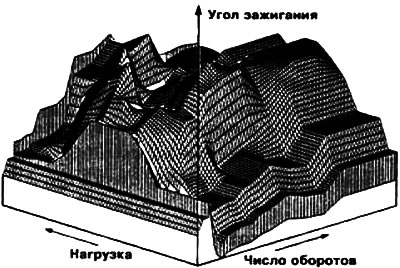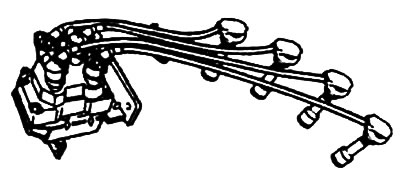The diesel engine does not need an ignition system, because due to the high compression ratio, the air heats up so much that after fuel injection, ignition occurs automatically.
Ford Mondeo gasoline engines are equipped with an electronic ignition system with performance control, and the functions of a traditional ignition distributor in such a system are performed by electronic elements. The ignition and injection functions are controlled by one control unit. Only vehicles with automatic transmission have a separate ignition control module.
The control device determines the optimal ignition timing on the basis of the technical characteristics recorded in the memory. As a result, the ignition system adapts more easily to different operating conditions, such as different fuel qualities. The distribution of the ignition voltage to the individual cylinders is performed by fixed electronic components. It is not necessary to check the ignition timing, since the ignition system does not contain moving parts, and the ignition timing cannot be changed.

The ignition voltage is generated by two ignition coils located in one housing, which, with each revolution of the crankshaft, send two igniting sparks at the right ignition moment. Each ignition coil provides two cylinders. While the ignition spark ignites the air-fuel mixture in the cylinder in which at that moment the compression stroke, the second ignition spark is supplied in the exhaust stroke of the corresponding cylinder. The ignition coil housing is attached to the cylinder head. The ignition system is synchronized by signals that are sent to the control device by two pulse sensors. One encoder is mounted on the flywheel, it registers the actual speed and position of the crankshaft based on the marks on the flywheel disc (molded jumpers). The second sensor measures the camshaft position for the intake valves. When performing work on the electronic ignition system, certain points must be strictly observed in order to prevent personal injury or failure of the ignition system.

The EEC IV ignition and injection module used in the Ford Mondeo is equipped with a fairly extensive self-test program and a memory device that recognizes errors that occur during vehicle operation and stores this information for a certain period of time (over 40 starts). The module displays more than 30 possible error codes on the indicator, but a control device and extensive Ford control documentation are required for interrogation. In the event of a malfunction, contact a Ford workshop.
Attention! If you disconnect the battery, all data stored in the error memory and set specifications, such as variable idle speed, will be erased. Problems may occur after reconnecting the battery (interruptions, the engine stalls on acceleration, works restlessly).
After connecting the battery, start the engine and let it idle for three minutes. After reaching operating temperature (the coolant temperature indicator is in the middle of the scale), give a little gas, the engine should run for the next two minutes at 1200 rpm. During this process, the module again remembers the technical data necessary for the operation of the engine. After that, you need to drive the car for 8 km at various speeds to complete the process "learning" and achieve normal operation.
Visitor comments